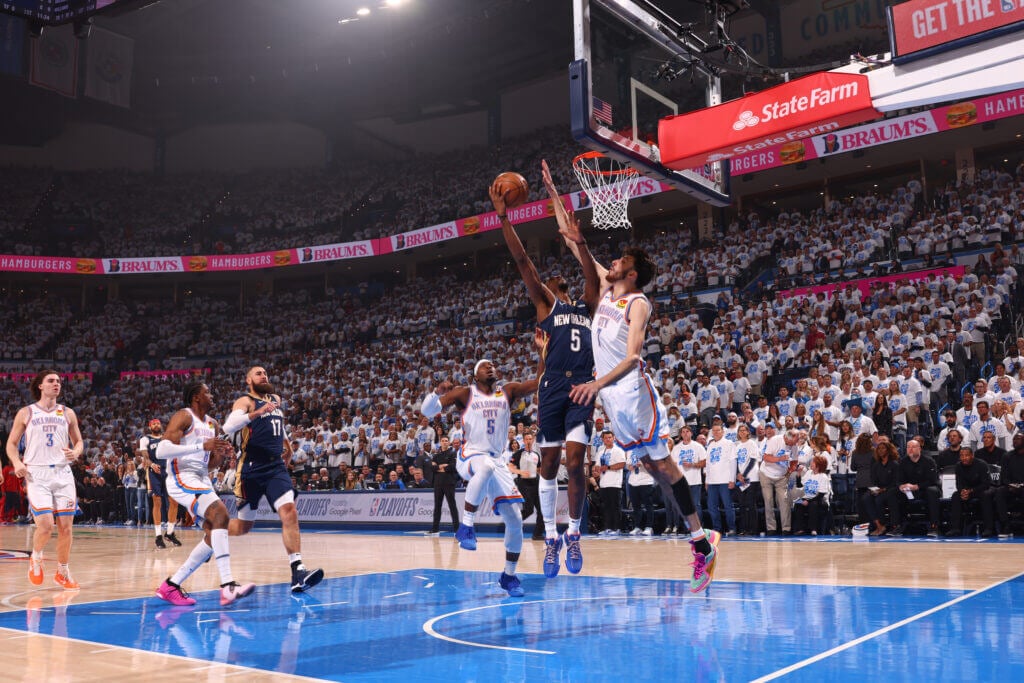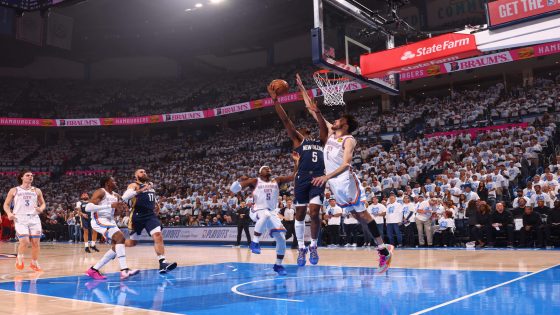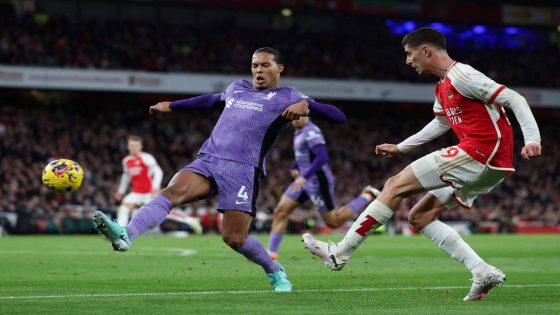
In their return to the playoff stage, the Oklahoma City Thunder gave up 18 offensive rebounds to the New Orleans Pelicans on Sunday night but still limited New Orleans to 92 points and won.
It was a shaky but ultimately successful Game 1 and a fitting welcome back, when considering Oklahoma City’s defensive profile this season. The Thunder finished with the NBA’s fourth-best defensive rating (111.0) despite the NBA’s third-worst rebounding rate (48.4 percent) and fourth-worst defensive rebounding rate (69.8 percent). The Portland Trail Blazers, Toronto Raptors and Washington Wizards are the only three teams that gave back a higher percentage of opponent misses.
In January, The Athletic published a piece on the Thunder’s top-five defense. They have the natural components for success — a bulldog stopper (Luguentz Dort), a disruptive deflector (Shai Gilgeous-Alexander, tied for the league lead with 150 steals), an elite rim protector (Chet Holmgren, second with 190 blocks) and a versatile guard-everyone wing (Jalen Williams) who allows for lineup flexibility.
But within the conversation with Thunder coach Mark Daigneault, the topic shifted to Oklahoma City’s trouble closing possessions with a defensive rebound. Daigneault, the likely NBA Coach of the Year and an honest interview, broke down the team’s philosophy in detail.
“Definitely concerned,” he said. “You never want to resign yourself to being bad at anything. So we’re constantly looking for ways to win some of the margins on the defensive glass. The NBA has a blockout stat. And for a while we were leading the league in blockouts, while we were last in the league in rebounding. So we’ve really learned a lot about rebounding in this process and tried to win on the margins. We had a little bit of a relapse at the beginning of January, but we had a run in December where we were like league average. From where we were, it was great. It’s all trade-offs.”
This is a calculated gamble from Thunder general manager Sam Presti, the architect of the roster, and Daigneault, who deploys the smaller, thinner, quicker lineup combinations. They’ve prioritized spacing and skill over pure power. They want everyone on the floor to shoot, pass and dribble with instinct. That includes the center spot. If the five-man spaces, there’s more room for Gilgeous-Alexander and Williams to drive. OKC finished with the league’s third-best offense (118.3 rating).
The Thunder faced some criticism at the deadline for not adding to a thin frontcourt. They helped facilitate the Daniel Gafford to Dallas trade but didn’t add him, waiting until buyout season to scoop up Bismack Biyombo on the minimum.
Biyombo is a traditional backup center who can carve out space and bang with Jonas Valančiūnas and all the world’s other 7-footers. He’s limited offensively, but Daigneault can call on him if needed. Just don’t expect it often. In Game 1, Daigneault went 11-deep into his rotation and didn’t use Biyombo. They started Holmgren at center and either used the undersized Jaylin Williams (seven minutes) as his backup or Kenrich Williams (a 6-foot-6 wing) in non-center lineups.
“There’s an offensive end of the floor, too, you know?” Daigneault said. “We want to be dynamic over there. We want to be hard to play against over there. So the rebounding is a cost to the other things that we’re benefiting from. But by no means is that something that we’re, like, excited about. We don’t we don’t like seeing teams get 18 offensive rebounds.”
That Daigneault quote is from January. But it might as well have been from Sunday night. The Pelicans bludgeoned the Thunder for 18 offensive rebounds on the glass. Valančiūnas had nine of those 18.
But quickly back to the Daigneault philosophy and the way he judges their effort on the defensive glass.
“It’s just digging into like all right: Where are we giving these ones up?” he said. “Where are the ones that are truly trade-offs? Maybe it’s where we’re playing small and Kenrich Williams is at the five and Daniel Theis jumps over him and gets the ball. It’s like ‘OK, that’s my fault.’ You know?”
There were a handful of those in Game 1, where it’s just a size problem. Valančiūnas accounted for most of them. He’s gigantic. It’s his specialty. He finished 18th in offensive rebounds this season.
The Pelicans have concerns about him surviving against the Thunder’s five-out spacing on the defensive end, but, when he’s on the floor, he’s going to get some extra possessions like the one below. Holmgren plays the pick-and-roll well, forcing Trey Murphy III into a hesitant attack and a well-contested floater. But Holmgren’s involvement allows Valančiūnas to get some leverage and overpower him for a rebound. It happens.
Daigneault was conducting that interview before a January game against the Utah Jazz, which gave him an example of the type of offensive rebounds he believes his team shouldn’t give up.
“Where are the ones that we have control over?” Daigneault said. “(Collin) Sexton’s a great rebounder. We’ll go over that. We should be able to turn around and crack him (when he crashes). If we’re not doing that, then that’s something we can control. That’s something that’s improvable.”
The Thunder gave up far too many avoidable offensive rebounds in Game 1, where they either fell asleep on their box-outs or failed to be physical enough. Here are a few examples, slowed down to see the mistake.
In the first: Keep your eye on Naji Marshall at the bottom of the screen. He slides right past Williams and Aaron Wiggins for an easy putback. Jalen Williams didn’t get a body on him, and Wiggins collapsed too deep into the paint.
In the second: Watch Herb Jones at the top of the screen. Gilgeous-Alexander is flat-footed when the shot goes up, turns his head the wrong way and then is too easily shoved aside as Jones skies in for the extra possession. This isn’t a strong enough box-out.
In the third: Holmgren doesn’t get a body on Larry Nance Jr. early enough, giving him a path to slither to the area of the ricochet and bat it to himself. Nance is aggressive on the crash and needs to be boxed out before he gets too much momentum.
The Thunder will remain vulnerable the rest of the playoffs to big offensive rebounding nights from opponents. They nearly lost in Game 1 after giving up three-on-one late fourth-quarter possession. But there are the unavoidable ones and the correctable errors. To go deep in the playoffs, they must limit the whiffed box-outs.
Required reading
(Top photo: Zach Beeker / NBAE via Getty Images)



